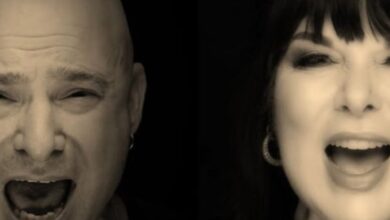Raw Metal Power Transforms “O Holy Night” Into a Breathtaking Modern Anthem
What immediately distinguished this rendition was its sense of purpose. Instead of chasing a novelty “metal Christmas” moment, Dan Vasc delivered “O Holy Night” with the sweeping magnitude of a cinematic power ballad. He preserved the hymn’s sacred essence while expanding it into a grand rock cathedral of emotion. Its December 2023 debut first appeared as a striking video—complete with atmospheric visuals—before the refined audio version arrived on streaming platforms. This gradual reveal helped fans recognize the piece not as a festive stunt, but as a heartfelt, enduring artistic declaration meant to outlast the holiday season.
Paying close attention reveals how the performance moves from serenity to storm. At the start, Vasc’s tone is humble, almost meditative, emphasizing phrasing and diction to honor the song’s timeless grace. Gradually, the soundscape widens—guitars rise like a wave, percussion gathers energy, and the orchestration blossoms into a full-scale symphony. By the time he sings “A thrill of hope,” the song has evolved into a climactic crescendo worthy of an arena stage. The journey from calm reverence to powerful exaltation embodies how metal can turn reflection into something transcendently alive.
The equilibrium between heaviness and air is what makes it work. Dan Vasc’s voice holds center focus, soaring above the instrumentation with commanding clarity while leaving room for every element to breathe. The mix highlights his crisp enunciation and unforced strength, maintaining the hymn’s dignity even as the guitars roar beneath. Instead of aggression, there’s uplift—a deliberate choice that channels the energy of faith through volume and precision rather than rebellion. The metal becomes a vessel of reverence, not defiance, magnifying holiness rather than mocking it.
Every production choice reinforces that intention. Layers of sound rise like architecture: piano underpins the harmonic structure, strings trace emotional arcs, and guitars inject drive into the foundation. Each bar feels as though it expands outward, drawing the listener deeper into a sonic cathedral. Drums support rather than dominate, forming a rhythmic scaffolding that lets the vocal radiate through stained-glass harmonies. The meticulous construction gives the music both weight and devotion—a reminder that power and piety can coexist without conflict.
The release schedule further amplified its impact. Arriving just before Christmas, the music video captured listeners seeking something heartfelt amid the festive noise. When the single surfaced again in January, it sparked a renewed wave of discovery, proving the track had life beyond seasonal playlists. It bridged the turn of the year, earning repeat plays long after decorations came down. In doing so, it carved a lasting place within the modern canon of winter classics, a song both timeless and fresh.
Vocally, this performance stands among Vasc’s finest. His midrange storytelling flows effortlessly into bold upper-register peaks that demand immense control. The final sustained note—a fusion of precision and grit—lands with breathtaking force. Even professional vocalists online noted how his emotional delivery mirrors his technical prowess, matching physical endurance with spiritual conviction. It’s the kind of moment that sends chills through both believers and rock fans alike, uniting them in shared awe at the sheer strength of human expression.
The arrangement also stays true to the hymn’s poetry, keeping the original text intact and letting the instrumentation frame its message. When the lyrics call the world to rejoice, thunderous drums and surging guitars rise in unison; when they urge “fall on your knees,” Vasc delivers with an intensity so vivid it feels illuminated from above. The power of the performance lies in that translation—sound as emotion, devotion as spectacle. The sacred message doesn’t fade beneath distortion; it’s amplified through it, glowing even brighter in the storm.
Reactions from fans revealed how deeply the song transcended genre barriers. Listeners who expected irony found sincerity instead. Many who usually prefer choral or classical renditions admitted being moved to tears by the metal approach, saying it rekindled the wonder of hearing the hymn for the first time. Meanwhile, metal devotees celebrated how their genre could honor something so pure without losing its edge. Across audiences, the response was the same: astonishment that reverence could roar this loudly and still sound beautiful.
This wide appeal reflects Vasc’s established identity as an interpreter rather than a parodist. His catalogue is built on reimagining beloved songs with gravity and grandeur, not irony. Fans who had followed his earlier hymn renditions knew to expect sincerity, which gave this release instant credibility. “O Holy Night” arrived not as a novelty, but as the latest in a lineage of musical tributes that fuse faith, art, and metal’s natural theatrical power.
The professionalism behind the project underscores that dedication. From orchestral swells to the disciplined rhythm section, every detail suggests collaboration among skilled musicians unified by purpose. The polished cinematography in the accompanying video adds visual reverence, complementing the audio’s emotional arc. Rather than a seasonal whim, it feels like a major studio effort designed to honor both the song and the season, showcasing how digital creators can rival mainstream production when guided by passion.
Treating the hymn as an epic arena piece allowed for dramatic visual storytelling. Each camera move, lighting cue, and backdrop shift syncs with the musical structure, producing goosebump-worthy crescendos. When the chorus invokes angels, the light seems to burst through the frame itself. It’s spectacle with substance—metal grandeur serving divine purpose. Few Christmas videos manage to feel both cinematic and reverent, yet this one achieves that fragile harmony effortlessly.
The song also meets a growing hunger for emotionally serious holiday music. Modern listeners crave arrangements that sound vast and filmic yet retain a core of intimacy. This version captures that balance perfectly, offering scale without irony, devotion without sentimentality. It invites everyone—believers, skeptics, musicians—to stand within its sound and feel the enormity of faith refracted through modern instruments. In that sense, it’s not only a performance but an experience of renewal.
Built for endurance, this “O Holy Night” thrives well beyond its debut year. Holiday music often fades with the decorations, but Vasc’s version endures because it fuses timeless melody with modern fire. Its replay value grows annually, satisfying listeners who crave not background cheer but catharsis. Within playlists of cozy pop and choir pieces, it stands out as a monument of emotion—something you don’t just hear, but feel.
Momentum continued as reactors, singers, and instrumentalists across YouTube discovered it, amplifying its reach through admiration. Each new reaction became another echo in a widening chorus of appreciation. That organic spread ensures the performance’s legacy—reborn each winter through community enthusiasm rather than marketing. For many, it has become a ritual of rediscovery: proof that faith, when expressed fearlessly, never truly leaves the stage.
When the last note fades, what remains isn’t mere showmanship but fulfillment—a triumph of spirit translated through volume and precision. The music doesn’t preach; it celebrates. This is why it continues to resonate, year after year: it embodies the sacred joy of the season through the language of modern power. “O Holy Night” has been sung countless times, but seldom with such electrifying reverence. Here, divinity meets distortion, and both emerge transformed.
Dan Vasc’s talent for reimagining monumental works was already proven through his stirring take on “Amazing Grace.” That earlier project revealed his ability to fuse redemption and defiance, turning a centuries-old hymn into a victorious anthem. Listeners responded to the sincerity—the way his metal arrangement sounded less like rebellion and more like resurrection. Its success paved the emotional foundation for “O Holy Night,” establishing trust that sacred music could thrive under heavy riffs without losing its soul.
His interpretation of “The Sound of Silence” further solidified his reputation as a bridge-builder between worlds. By transforming a quiet reflection into a towering rock odyssey, he showcased how intensity can coexist with fragility. Fans discovered that under his guidance, familiar melodies gained new emotional dimensions. The lineage now feels complete: “Amazing Grace,” “The Sound of Silence,” and “O Holy Night”—three songs reborn through the same fearless voice. Together, they form a testament to music’s ability to make the ancient feel immediate, the sacred sound infinite.





